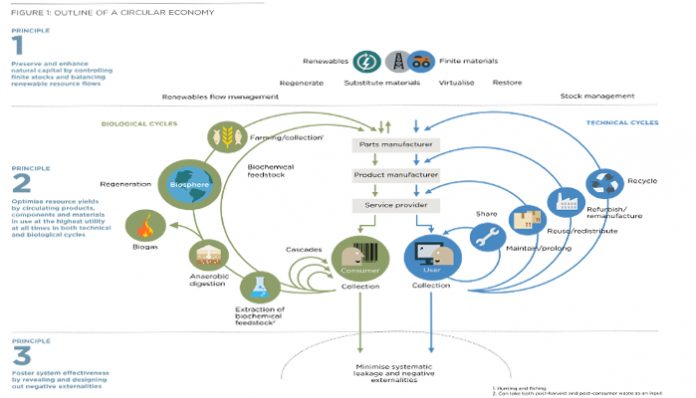The Circular Economy is the most significant new concept in sustainability and economic development. Starting with this issue, we are commencing a new series of articles that will explain this new concept and talk about how it can influence the design of packaging and industry in general going forward – Editor.
The latest concepts in sustainability are all centered around building circular economies. It all started off with the realization that the primary focus of sustainability has to shift to the conservation and preservation of our natural resources, especially non-renewable resources and those that are not renewable in the near term (like coal or fossil fuels), from just the protection of the environment and eco-systems. While the latter is certainly important to sustain the quality of life and to prevent deterioration of living conditions, the more real threat is that we are going to run out of resources some time in the future.
Indeed, we have had an excellent track record of technology development over the last four decades in alleviating the ecological situation. For example, when the global energy crisis hit us in 1974, we were actually flaring every bit of natural gas instead of putting it to use or focusing on developing technologies to make its use as a feedstock commercially viable. Since then, we have been able to see this happen and, if anything, natural gas has become the preferred feedstock for petro-chemicals and heating/cooking (both domestic and industrial). Likewise, electrical and hybrid vehicles are soon expected to overtake conventional vehicles that use traditional internal combustion engines based on fossil fuels. Industry is also constantly working on efficiency in usage of energy and natural resources. While all this will certainly mitigate the situation in the short to medium term, this will only only help in postponing the inevitable depletion and eventual drying up of reserves of non-renewable resources.
This is where circular economies come in. We need to rapidly work towards development of circular economies to replace our linear economies which overwhelmingly rule the roost today.
Linear economies
Today, the world is totally dominated by linear economies where the linear ‘take, make, dispose’ economic model rules supreme. Economic development and manufacture and consumption of products has evolved solely on linear designs. This model relies on large quantities of cheap, easily accessible raw materials and energy. The sequence of all manufacturing activity and consumption is:
• Manufacture or acquire all required resources
• Convert these resources into products
• Use these products
• Dispose of residual product waste after use
While this model has been highly successful in generating industrial development and engendering high rates of growth, no deliberate attention is paid to conservation of resources. This has necessitated rethinking on use of energy and resources. Even though the design philosophy of product cycles that evolved was a ‘cradle to grave’ concept which does focus a lot of attention on handling and disposal of post-use waste as part of the overall life cycle, there was no conscious effort to see that resources used were either re-used, recycled or regenerated to enable their fresh use as inputs for new product cycles. While the focus on reduction of resource use and reduction of fossil energy per unit of economic output in the 20th and 21st centuries has been noteworthy, this has only succeeded in postponing but not avoiding the impending resource crunch, albeit in the longer term future.
Even the most advanced linear economies are surprisingly wasteful in their models of value creation. In Europe, material recycling and waste-based energy recovery captures only 5% of the original raw material value. Analysis has also found significant structural waste in sectors that many would consider mature and optimized. For example, in Europe, the average car is parked 92% of the time and 31% of food is wasted along the value chain. Rapid urbanization is only going to make things worse. (Overall demographic growth is projected to bring the global proportion of people living in cities to 66% by 2050.)
All this led to the ‘cradle to cradle’ concept that gave rise to thinking of circular economies as the way forward. The rationale for transitioning to a circular model is increasingly gaining ground.
Circular economies
What is a Circular Economy? A circular economy is one that is restorative and regenerative by conscious design. It aims to keep products, components, and materials at their highest utility and value at all times, distinguishing between technical and biological cycles. A circular economy addresses and focuses completely on optimal usage of resources. The accent is to try and use renewable resources wherever possible; even if non-renewable resources are used, they have to be restored or regenerated at the end of the product life cycle so that they can be used once more in new product cycles so that there is no drain on finite reserves of these non-renewable resources. This new economic model seeks to ultimately decouple global economic development from finite resource consumption. while optimally managing the flow of renewable resources. The circular economy deliberately designs out wastage from the system.
The fundamental design of this model is based on circular loops and loops within loops. Given below is a structural design developed by the Ellen MacArthur Foundation (the pioneers and prime movers of the circular economy concept) and McKinsey.
One of the sectors that has been identified as key to the success of implementing circular economies is plastics, especially plastic packaging. (The packaging sector accounts for about 40% of global plastics usage.)
While the concept of circular economies is truly futuristic and not so easy to implement in the short term, some countries like Japan are well ahead of the curve and really need to be complimented for their efforts. As far back as 2000, Japan developed and enacted their Law for the Promotion of Efficient Utilization of Resources. The law treats materials as vital resources and mandates the use of disassembly plants aimed at recovery and restoration of materials. This has led to significant recovery of many materials like metals that were hitherto deemed as waste and consigned to disposal systems like landfills.
In the next few issues, we will discuss some of these concepts in more detail and present relevant case studies.












